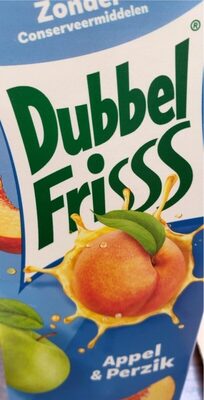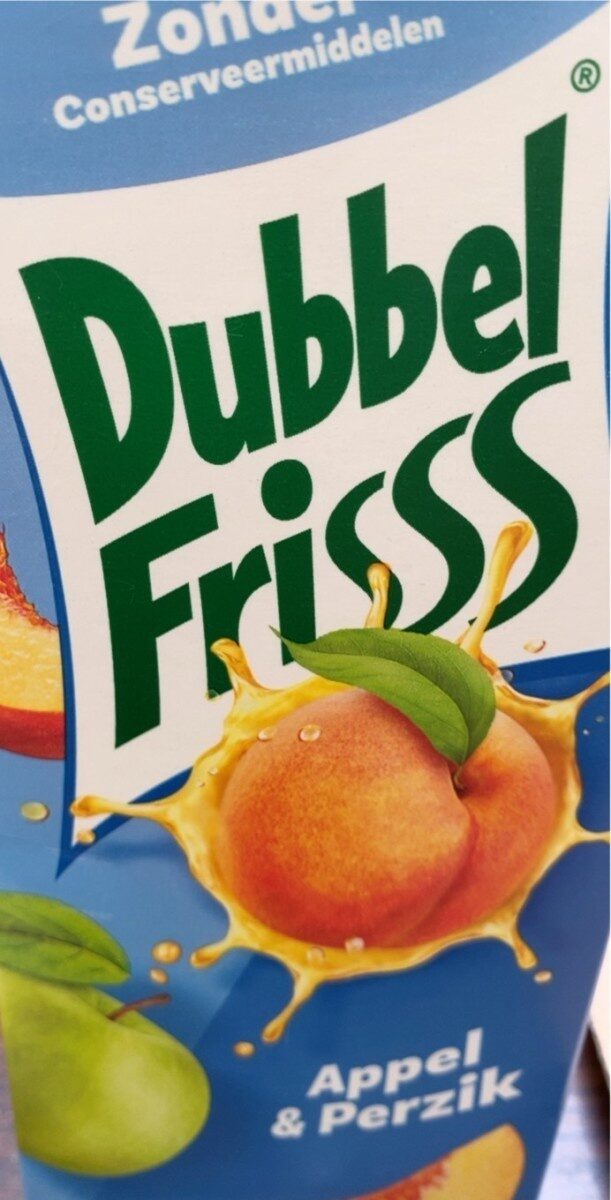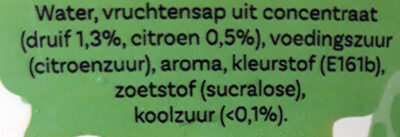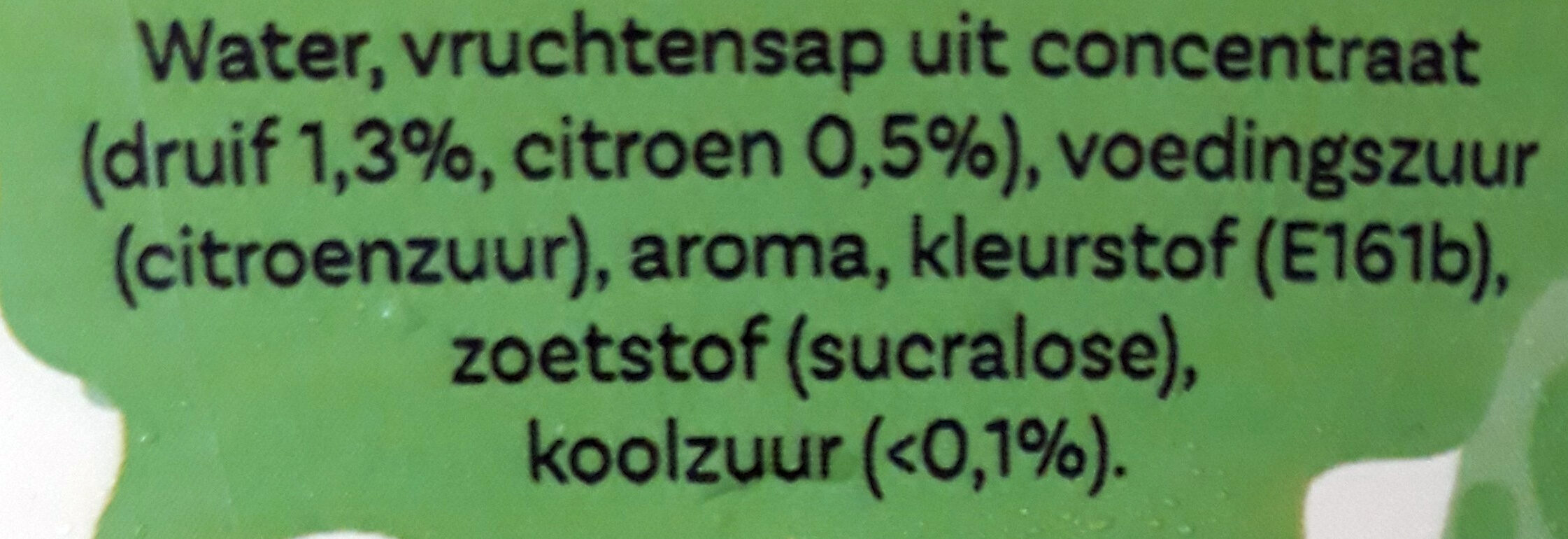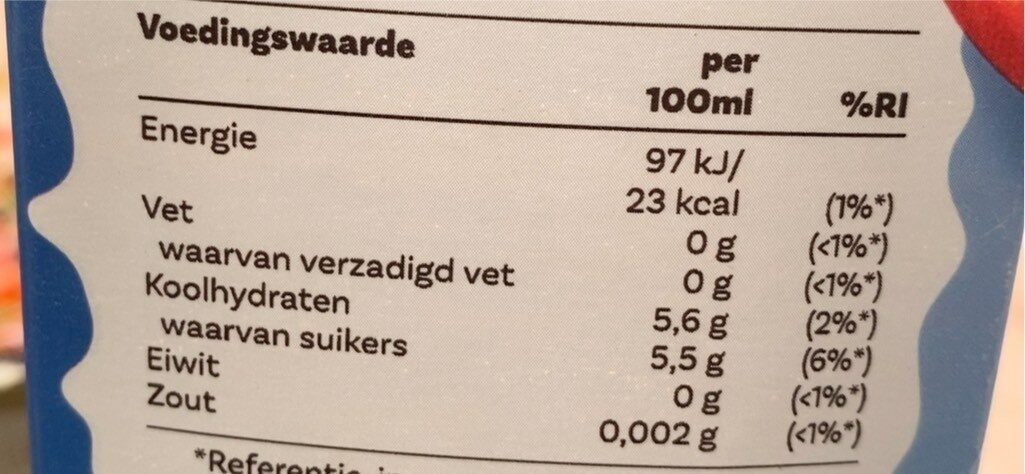Help us make food transparency the norm!
As a non-profit organization, we depend on your donations to continue informing consumers around the world about what they eat.
The food revolution starts with you!
Appel & perzik - dubbelfrisss - 1,5 l
Appel & perzik - dubbelfrisss - 1,5 l
This product page is not complete. You can help to complete it by editing it and adding more data from the photos we have, or by taking more photos using the app for Android or iPhone/iPad. Thank you!
×
Barcode: 8720157463764 (EAN / EAN-13)
Quantity: 1,5 l
Packaging: Plastic
Brands: Dubbelfrisss
Categories: Plant-based foods and beverages, Beverages, Plant-based beverages, Fruit-based beverages, Juices and nectars, Artificially sweetened beverages
Traceability code: 92201091058
Link to the product page on the official site of the producer: http://www.dubbelfrisss.nl
Stores: Boon's
Countries where sold: Netherlands
Matching with your preferences
Health
Ingredients
-
12 ingredients
: Water, vruchtensap uit concentraat (druif 1,3%, citroen 0,5%), voedingszuur (citroenzuur), aroma, kleurstof (E161b), zoetstof (sucralose), koolzuur (<0,1%).
Food processing
-
Ultra processed foods
Elements that indicate the product is in the 4 - Ultra processed food and drink products group:
- Additive: E161b - Lutein
- Additive: E290 - Carbon dioxide
- Additive: E955 - Sucralose
- Ingredient: Colour
- Ingredient: Flavouring
- Ingredient: Sweetener
- Ingredient: Fruit juice concentrate
Food products are classified into 4 groups according to their degree of processing:
- Unprocessed or minimally processed foods
- Processed culinary ingredients
- Processed foods
- Ultra processed foods
The determination of the group is based on the category of the product and on the ingredients it contains.
Additives
-
E290 - Carbon dioxide
Carbon dioxide: Carbon dioxide -chemical formula CO2- is a colorless gas with a density about 60% higher than that of dry air. Carbon dioxide consists of a carbon atom covalently double bonded to two oxygen atoms. It occurs naturally in Earth's atmosphere as a trace gas. The current concentration is about 0.04% -410 ppm- by volume, having risen from pre-industrial levels of 280 ppm. Natural sources include volcanoes, hot springs and geysers, and it is freed from carbonate rocks by dissolution in water and acids. Because carbon dioxide is soluble in water, it occurs naturally in groundwater, rivers and lakes, ice caps, glaciers and seawater. It is present in deposits of petroleum and natural gas. Carbon dioxide is odorless at normally encountered concentrations, however, at high concentrations, it has a sharp and acidic odor.As the source of available carbon in the carbon cycle, atmospheric carbon dioxide is the primary carbon source for life on Earth and its concentration in Earth's pre-industrial atmosphere since late in the Precambrian has been regulated by photosynthetic organisms and geological phenomena. Plants, algae and cyanobacteria use light energy to photosynthesize carbohydrate from carbon dioxide and water, with oxygen produced as a waste product.CO2 is produced by all aerobic organisms when they metabolize carbohydrates and lipids to produce energy by respiration. It is returned to water via the gills of fish and to the air via the lungs of air-breathing land animals, including humans. Carbon dioxide is produced during the processes of decay of organic materials and the fermentation of sugars in bread, beer and wine making. It is produced by combustion of wood and other organic materials and fossil fuels such as coal, peat, petroleum and natural gas. It is an unwanted byproduct in many large scale oxidation processes, for example, in the production of acrylic acid -over 5 million tons/year-.It is a versatile industrial material, used, for example, as an inert gas in welding and fire extinguishers, as a pressurizing gas in air guns and oil recovery, as a chemical feedstock and as a supercritical fluid solvent in decaffeination of coffee and supercritical drying. It is added to drinking water and carbonated beverages including beer and sparkling wine to add effervescence. The frozen solid form of CO2, known as dry ice is used as a refrigerant and as an abrasive in dry-ice blasting. Carbon dioxide is the most significant long-lived greenhouse gas in Earth's atmosphere. Since the Industrial Revolution anthropogenic emissions – primarily from use of fossil fuels and deforestation – have rapidly increased its concentration in the atmosphere, leading to global warming. Carbon dioxide also causes ocean acidification because it dissolves in water to form carbonic acid.Source: Wikipedia
-
E330 - Citric acid
Citric acid is a natural organic acid found in citrus fruits such as lemons, oranges, and limes.
It is widely used in the food industry as a flavor enhancer, acidulant, and preservative due to its tart and refreshing taste.
Citric acid is safe for consumption when used in moderation and is considered a generally recognized as safe (GRAS) food additive by regulatory agencies worldwide.
-
E955 - Sucralose
Sucralose: Sucralose is an artificial sweetener and sugar substitute. The majority of ingested sucralose is not broken down by the body, so it is noncaloric. In the European Union, it is also known under the E number E955. It is produced by chlorination of sucrose. Sucralose is about 320 to 1‚000 times sweeter than sucrose, three times as sweet as both aspartame and acesulfame potassium, and twice as sweet as sodium saccharin. Evidence of benefit is lacking for long-term weight loss with some data supporting weight gain and heart disease risks.It is stable under heat and over a broad range of pH conditions. Therefore, it can be used in baking or in products that require a long shelf life. The commercial success of sucralose-based products stems from its favorable comparison to other low-calorie sweeteners in terms of taste, stability, and safety. Common brand names of sucralose-based sweeteners are Splenda, Zerocal, Sukrana, SucraPlus, Candys, Cukren, and Nevella. Canderel Yellow also contains sucralose, but the original Canderel and Green Canderel do not.Source: Wikipedia
Ingredients analysis
-
Palm oil free
No ingredients containing palm oil detected
-
Vegan status unknown
Unrecognized ingredients: Fruit juice from concentrate
-
Vegetarian status unknown
Unrecognized ingredients: Fruit juice from concentrate
-
Details of the analysis of the ingredients
: Water, vruchtensap uit concentraat (druif 1.3%, citroen 0.5%), voedingszuur (citroenzuur), aroma, kleurstof (e161b), zoetstof (sucralose), koolzuur 0.1%- Water -> en:water - vegan: yes - vegetarian: yes - ciqual_food_code: 18066 - percent_min: 90.9 - percent_max: 97.7
- vruchtensap uit concentraat -> en:fruit-juice-from-concentrate - percent_min: 1.8 - percent_max: 1.8
- druif -> en:grape - vegan: yes - vegetarian: yes - ciqual_food_code: 13112 - percent_min: 1.3 - percent: 1.3 - percent_max: 1.3
- citroen -> en:lemon - vegan: yes - vegetarian: yes - ciqual_proxy_food_code: 13009 - percent_min: 0.5 - percent: 0.5 - percent_max: 0.5
- voedingszuur -> en:acid - percent_min: 0.1 - percent_max: 1.8
- citroenzuur -> en:e330 - vegan: yes - vegetarian: yes - percent_min: 0 - percent_max: 1.8
- aroma -> en:flavouring - vegan: maybe - vegetarian: maybe - percent_min: 0.1 - percent_max: 1.8
- kleurstof -> en:colour - percent_min: 0.1 - percent_max: 1.8
- e161b -> en:e161b - vegan: yes - vegetarian: yes - percent_min: 0 - percent_max: 1.8
- zoetstof -> en:sweetener - percent_min: 0.1 - percent_max: 1.8
- sucralose -> en:e955 - vegan: yes - vegetarian: yes - percent_min: 0 - percent_max: 1.8
- koolzuur -> en:e290 - vegan: yes - vegetarian: yes - percent_min: 0.1 - percent: 0.1 - percent_max: 0.1
Nutrition
-
Poor nutritional quality
⚠ ️Warning: the amount of fruits, vegetables and nuts is not specified on the label, it was estimated from the list of ingredients: 1This product is considered a beverage for the calculation of the Nutri-Score.
Positive points: 0
- Proteins: 0 / 5 (value: 0, rounded value: 0)
- Fiber: 0 / 5 (value: 0, rounded value: 0)
- Fruits, vegetables, nuts, and colza/walnut/olive oils: 0 / 10 (value: 1.8, rounded value: 1.8)
Negative points: 8
- Energy: 4 / 10 (value: 97, rounded value: 97)
- Sugars: 4 / 10 (value: 5.5, rounded value: 5.5)
- Saturated fat: 0 / 10 (value: 0, rounded value: 0)
- Sodium: 0 / 10 (value: 0.8, rounded value: 0.8)
The points for proteins are counted because the negative points are less than 11.
Nutritional score: (8 - 0)
Nutri-Score:
-
Nutrient levels
-
Fat in low quantity (0%)
What you need to know- A high consumption of fat, especially saturated fats, can raise cholesterol, which increases the risk of heart diseases.
Recommendation: Limit the consumption of fat and saturated fat- Choose products with lower fat and saturated fat content.
-
Saturated fat in low quantity (0%)
What you need to know- A high consumption of fat, especially saturated fats, can raise cholesterol, which increases the risk of heart diseases.
Recommendation: Limit the consumption of fat and saturated fat- Choose products with lower fat and saturated fat content.
-
Sugars in moderate quantity (5.5%)
What you need to know- A high consumption of sugar can cause weight gain and tooth decay. It also augments the risk of type 2 diabetes and cardio-vascular diseases.
Recommendation: Limit the consumption of sugar and sugary drinks- Sugary drinks (such as sodas, fruit beverages, and fruit juices and nectars) should be limited as much as possible (no more than 1 glass a day).
- Choose products with lower sugar content and reduce the consumption of products with added sugars.
-
Salt in low quantity (0.002%)
What you need to know- A high consumption of salt (or sodium) can cause raised blood pressure, which can increase the risk of heart disease and stroke.
- Many people who have high blood pressure do not know it, as there are often no symptoms.
- Most people consume too much salt (on average 9 to 12 grams per day), around twice the recommended maximum level of intake.
Recommendation: Limit the consumption of salt and salted food- Reduce the quantity of salt used when cooking, and don't salt again at the table.
- Limit the consumption of salty snacks and choose products with lower salt content.
-
-
Nutrition facts
Nutrition facts As sold
for 100 g / 100 mlAs sold
per serving (100ml)Compared to: Artificially sweetened beverages Energy 97 kj
(23 kcal)97 kj
(23 kcal)+98% Fat 0 g 0 g -100% Saturated fat 0 g 0 g -100% Carbohydrates 5.6 g 5.6 g +130% Sugars 5.5 g 5.5 g +164% Fiber 0 g 0 g -100% Proteins 0 g 0 g -100% Salt 0.002 g 0.002 g -95% Fruits‚ vegetables‚ nuts and rapeseed‚ walnut and olive oils (estimate from ingredients list analysis) 1.8 % 1.8 %
Environment
-
Eco-Score C - Moderate environmental impact
⚠ ️Select a country in order to include the full impact of transportation.The Eco-Score is an experimental score that summarizes the environmental impacts of food products.→ The Eco-Score was initially developped for France and it is being extended to other European countries. The Eco-Score formula is subject to change as it is regularly improved to make it more precise and better suited to each country.Life cycle analysis
-
Average impact of products of the same category: B (Score: 64/100)
Category: Fruit soft drink, still (fruit juice content unspecified), with sugar
Category: Fruit soft drink, still (fruit juice content unspecified), with sugar
- PEF environmental score: 0.10 (the lower the score, the lower the impact)
- including impact on climate change: 0.56 kg CO2 eq/kg of product
Stage Impact Agriculture
29.5 %Processing
4.9 %Packaging
39.1 %Transportation
15.1 %Distribution
9.0 %Consumption
2.5 %
Bonuses and maluses
-
Missing origins of ingredients information
Malus: -5
⚠ ️ The origins of the ingredients of this product are not indicated.
If they are indicated on the packaging, you can modify the product sheet and add them.
If you are the manufacturer of this product, you can send us the information with our free platform for producers.
-
Packaging with a medium impact
Malus: -10
Shape Material Recycling Impact Unknown Plastic High ⚠ ️ The information about the packaging of this product is not sufficiently precise (exact shapes and materials of all components of the packaging).⚠ ️ For a more precise calculation of the Eco-Score, you can modify the product page and add them.
If you are the manufacturer of this product, you can send us the information with our free platform for producers.
Eco-Score for this product
-
Impact for this product: C (Score: 49/100)
Product: Appel & perzik - dubbelfrisss - 1,5 l
Life cycle analysis score: 64
Sum of bonuses and maluses: -15
Final score: 49/100
-
Carbon footprint
-
Equal to driving 0.3 km in a petrol car
56 g CO² per 100g of product
The carbon emission figure comes from ADEME's Agribalyse database, for the category: Fruit soft drink, still (fruit juice content unspecified), with sugar (Source: ADEME Agribalyse Database)
Stage Impact Agriculture
16.3 %Processing
10.6 %Packaging
31.7 %Transportation
33.9 %Distribution
6.3 %Consumption
1.2 %
Packaging
-
Packaging with a medium impact
-
Packaging parts
(Plastic)
-
Packaging materials
Material % Packaging weight Packaging weight per 100 g of product Plastic
-
Transportation
-
Origins of ingredients
Missing origins of ingredients information
⚠ ️ The origins of the ingredients of this product are not indicated.
If they are indicated on the packaging, you can modify the product sheet and add them.
If you are the manufacturer of this product, you can send us the information with our free platform for producers.Add the origins of ingredients for this product Add the origins of ingredients for this product
Report a problem
-
Incomplete or incorrect information?
Category, labels, ingredients, allergens, nutritional information, photos etc.
If the information does not match the information on the packaging, please complete or correct it. Open Food Facts is a collaborative database, and every contribution is useful for all.
Data sources
Product added on by openfoodfacts-contributors
Last edit of product page on by aleene.
Product page also edited by kiliweb, off.477d0cd8-28ef-4f46-9022-a32fbc8ecfe9, packbot, yuka.sY2b0xO6T85zoF3NwEKvlhRITuLkuGnIKhzUiRWQ9I6iCcXjWuBPy5T4H6s.
